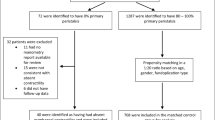Abstract
Background: The 1outcomes of a laparoscopic esophagomyotomy with posterior partial fundoplication were compared between groups of patients with primary motility disorders.
Methods: In this study, 47 patients (26 women and 21 men, ages 24 to 77 years; mean, 47 years) with significant dysphagia or chest pain who failed conservative treatment underwent a laparoscopic esophagomyotomy and posterior partial fundoplication. Preoperative evaluation revealed four groups of primary motility disorders: achalasia (n=12), nutcracker esophagus (n=12), hypertensive lower esophageal sphincter (LES) (n=16), and diffuse esophageal spasm (n=7). Statistical analysis was performed by Cramer’s V test.
Results: Average follow-up period was 30.3 months. There was no mortality or early morbidity. Late morbidity included dysphagia or chest pain over 6 weeks in 10 patients (21%), recurrent gastroesophageal reflux disease (GERD) in 3 patients (6%), and recurrent motility disorder in 2 patients (4%). Overall, 94% of the patients ultimately had complete resolution of dysphagia or chest pain. There was no significant difference in outcomes between groups.
Conclusion: Early results suggest that laparoscopic esophagomyotomy with posterior partial fundoplication provides safe and effective relief from dysphagia and chest pain in patients with each of the primary motility disorders.
Similar content being viewed by others
References
Anselmino M, Zaninotto G, Costantini M, Rossi M, Boccu C, Molena D, Ancona E (1997) One-year follow-up after laparoscopic Heller-Dor operation for esophageal achalasia. Surg Endosc 11: 3–7 DOI: 10.1007/s004649900283
Belsey R (1977) Mark four repair of hiatal hernia by the transthoracic approach. World J Surg 1: 475–481
Castell D, Castell J (1994) Esophageal motility testing. Appleton and Lange, Norwalk, CT
Champion J, Delisle N, Hunt T (1999) Comparison of thoracoscopic and laparoscopic esophagomyotomy with fundoplication for primary motility disorders. Eur J Cardiothorac surg 15: 1–3 DOI: 10.1016/S1010-7940(98)00295-4
Champion J, McKernan J (1996) Thoracoscopy and gastroesophageal reflux. In: Hunter J (ed) Problems in general surgery. Lippincott-Raven, Philadelphia, pp 97–103
Demeester T (1982) Surgery for esophageal motility disorders. Ann Thorac Surg 34: 225–229
Fenton K, Miller J, Lee R, Mansour K (1997) Belsey mark four anti-reflux procedure for complicated gastroesophageal reflux disease. Ann Thorac Surg 64: 790–794 DOI: 10.1016/S0003-4975(97)00625-5
Filipi C, Hinder R (1994) Thoracoscopic esophageal myotomy; a surgical technique for achalasia, diffuse esophageal spasm, and “nutcracker esophagus.” Surg Endosc 8: 921–926
Henderson R, Ryder D (1982) Reflux control following myotomy in diffuse esophageal spasm. Ann Thorac Surg 34: 230–235
Hunter J, Richardson W (1997) Surgical management of achalasia. Surg Clin 77: 993–1015
Liu H, Huang B, Hsu W, Huang C, Hoy S, Huang M (1998) Surgery for achalasia: long-term results in operated achalasic patients. Ann Thorac Cardiovasc Surg 4: 312–320
McBride P, Hinder R, Filipi C, Raiser F, Katada N, Lund R (1987) Surgical treatment of spastic conditions of the esophagus. Int Surg 82: 133–118
McKernan J, Champion J (1998) Minimally invasive anti-reflux surgery. Am J Surg 175: 271–276 DOI: 10.1016/S0002-9610(98)00034-8
Miller L, Parkman H, Schiano T, Cassidy M, Ter R, Dabezies M, Cohen S, Fisher R (1996) Treatment of symptomatic non-achalasia esophageal motor disorders with botulinum toxin injection at the lower esophageal sphincter. Dig Dis Sci 41: 2025–2031
Nguyen N, Schauer P, Hutson W, Landreneau R, Weigel T, Ferson P, Keenan R, Luketich J (1998) Preliminary results of thoracoscopic Belsey mark IV antireflux procedure. Surg Laparosc Endosc 8: 185–188
Orringer M, Skinner D, Belsey R (1972) Long-term results of the mark four operation for hiatal hernia and analysis of recurrences and their treatment. J Thorac Cardiovasc Surg 63: 25–31
Patti M, Pellegrini C, Arlerito M, Tong J, MuluiHill S, Way L (1995) Comparison of medical and minimally invasive surgical therapy for primary esophageal motility disorders. Arch Surg 130: 609–616
Patti M, Way L (1997) Evaluation and treatment of primary esophageal motility disorders. West J Med 166: 263–269
Pellegrini C (1997) Impact and evolution of minimally invasive techniques in the treatment of achalasia. Surg Endosc 11: 1–2 DOI: 10.1007/s004649900282
J Gastrointestinal Surg 3: 100–101
Streitz J, Ellis F, Williamson W, Glick M, AASJ, Tilden R (1996) Objective assessment of gastroesophageal reflux after short esophagomyotomy for achalasia with the use of manometry and pH monitoring. J Thorac Cardiovasc Surg 111: 107–113
Swanstorm L, Pennings J (1995) Laparoscopic esophagomyotomy for achalasia. Surg Endosc 9: 286–292
Vaezim RI (1998) Current therapies for achalasia: comparison and efficacy. J Clin Gastroenterol 27: 21–35
Waring P, Hunter J, Oddsdottir M, Wo J, Katz E (1995) The preoperative evaluation of patients considered for laparoscopic antireflux surgery. Am J Gastroenterol 90: 35–38
Author information
Authors and Affiliations
Additional information
Online publication: 13 June 2000
Rights and permissions
About this article
Cite this article
Champion, J.K., Delisle, N. & Hunt, T. Laparoscopic esophagomyotomy with posterior partial fundoplication for primary esophageal motility disorders. Surg Endosc 14, 746–749 (2000). https://doi.org/10.1007/s004640000147
Received:
Accepted:
Issue Date:
DOI: https://doi.org/10.1007/s004640000147




